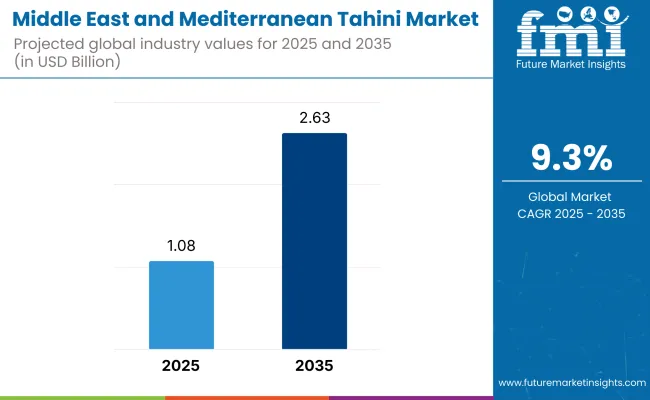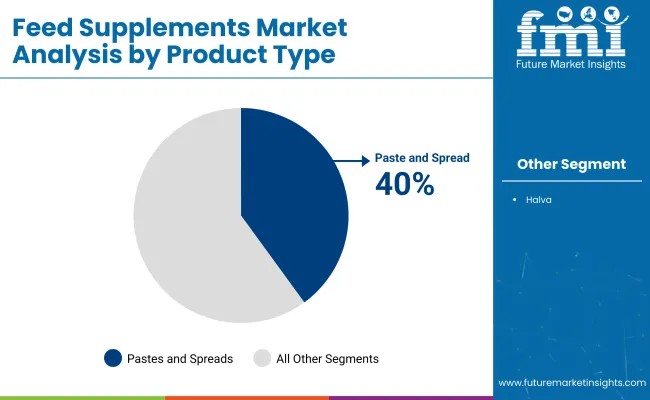The demand for Middle East and Mediterranean Tahini market is expected to be valued at USD 1.08 Billion in 2025, forecasted at a CAGR of 9.3% to have an estimated value of USD 2.63 Billion from 2025 to 2035. From 2020 to 2025 a CAGR of 8.8% was registered for the market.

| Attributes | Description |
|---|---|
| Estimated Global Industry Size (2025E) | USD 1.08 Billion |
| Projected Global Industry Value (2035F) | USD 2.63 Billion |
| Value-based CAGR (2025 to 2035) | 9.3% |
The demand for tahini is rising dramatically in the Mediterranean and Middle East due to the delicacy’s high consumption. As a result, the majority of the products manufacturers are based there. Additionally, these businesses value their devoted clientele which is why they want to expand into the Middle East and Mediterranean region. Tahini is a common food item in the area on its own.
The regions food products popularity has been handed down from one generation to the next. As a result, the food item is still very popular and continues to rise in the populations estimation.
Tahini is mostly used in the preparation of different treats. Middle Eastern families and those involved in the food industry treasure the product because it can be used to make delicious dishes like baba ghanoush and hummus.
In addition, the condiment is utilized in the preparation of dips sauces and pastes. Consequently, the product is used in a variety of ways and the industry has several growth prospects in the area.
A significant contributor to the condiments ongoing popularity in the area is its use as a component in desserts. Arabic people are known for eating a lot of sweets and it is common for families to serve a sweet with every meal.
Thus, the industry benefits from the products use in the production of sweets like halva. But the tahini industry in the Middle East and the Mediterranean is also a little sour. People who are concerned about their health avoid the condiment because of its high fat content.

| Segment | Value Share (2025) |
| Pastes and Spreads (Product Type) | 40% |
In 2025 it is projected that 40% of the tahini market will be made up of pastes and spreads. Pastes and spreads are benefiting from the growing preference for packaged foods in the Mediterranean and Middle East. One of the main reasons pastes and spreads are getting more attention is the region’s growing bakery industry. Spreads are expected to grow rapidly in Saudi Arabia in particular. Thus, pastes and spreads triumph over other product types in the tahini industry.
Demand in Vegan Food is Driving the Market Growth
Even though the Middle East and Mediterranean are known for their meat-based cuisine a sizable portion of the population is vegan or vegetarian. According to estimates 6 percent of people in the Middle East are vegan and 16 percent are vegetarian. Tahini and other seed-based products have a lot of room to grow in the area.
During the period 2020 to 2024, the sales grew at a CAGR of 8.8%, and it is predicted to continue to grow at a CAGR of 9.3% during the forecast period of 2025 to 2035.
The pandemic caused more people to stay at home and the popularity of home-cooked meals sent the local population into a frenzy. Production and sales of the condiment consequently skyrocketed. However, the industry was adversely affected by the closure of restaurants and hotels. The restaurant industry provides a significant portion of the stakeholder’s income.
The industry experienced a sharp decline as the restaurants were forced to close. However, the tahini industry once again found its sweet spot with the reopening of restaurants. Compared to the historical period the demand is anticipated to increase even more quickly during the forecast period. The expansion of the industry is significantly aided by the Middle East and Mediterraneans expanding hotel and restaurant chains.
The regions tahini industry stands to gain as more consumers use pastes spreads and sauces in their meals. Tahini is seeing a rise in sales as more and more of these foods contain seed-based ingredients. Additionally, producers have long relied on the sweet tooths of the Middle Eastern and Mediterranean population to generate demand.
Tier 1 companies comprises industry leaders acquiring a 60% share in the global business market. These leaders are distinguished by their extensive product portfolio and high production capacity. These industry leaders stand out due to their broad geographic reach, in-depth knowledge of manufacturing and reconditioning across various formats and strong customer base. They offer a variety of services and manufacturing with the newest technology while adhering to legal requirements for the best quality.
Tier 2 companies comprises of mid-size players having a presence in some regions and highly influencing the local commerce and has a market share of 30%. These are distinguished by their robust global presence and solid business acumen. These industry participants may not have cutting-edge technology or a broad global reach but they do have good technology and guarantee regulatory compliance.
Tier 3 companies comprises mostly of small-scale businesses serving niche economies and serving at the local presence having a market share of 10%. Due to their notable focus on meeting local needs these businesses are categorized as belonging to the tier 3 share segment, they are minor players with a constrained geographic scope. As an unorganized ecosystem Tier 3 in this context refers to a sector that in contrast to its organized competitors, lacks extensive structure and formalization.
Since the Middle East is the condiments historical stronghold many of the biggest tahini companies are based there. Even though home-made production is important the majority of the market is controlled by a small number of businesses.
El Rashidi El Mizan one of the well-known businesses in the area focuses on providing natural and healthful products made from the condiment. The well-known Al-Wadi Al-Akhdar S. A brand is another. L who boasts that the product is free of whitening agents also ensures that it is healthful. Therefore, the desire to offer all-natural tahini can be considered a primary goal for regional industry participants.
By product, industry has been categorized into pastes and spread, halva
North America,Latin America,Western Europe,Eastern Europe,Balkans & Baltic,Russia & Belarus,Central Asia,East Asia,South Asia & Pacific,Middle East & Africa
The market is expected to grow at a CAGR of 9.3% throughout the forecast period.
By 2035, the sales value is expected to be worth USD 2.63 Billion.
Demand for vegan food is increasing demand for Middle East and Mediterranean Tahini Market.
Some of the key players in manufacturing include El Rashidi El Mizan, Halwani Bros. Co and more.






Our Research Products

The "Full Research Suite" delivers actionable market intel, deep dives on markets or technologies, so clients act faster, cut risk, and unlock growth.

The Leaderboard benchmarks and ranks top vendors, classifying them as Established Leaders, Leading Challengers, or Disruptors & Challengers.

Locates where complements amplify value and substitutes erode it, forecasting net impact by horizon

We deliver granular, decision-grade intel: market sizing, 5-year forecasts, pricing, adoption, usage, revenue, and operational KPIs—plus competitor tracking, regulation, and value chains—across 60 countries broadly.

Spot the shifts before they hit your P&L. We track inflection points, adoption curves, pricing moves, and ecosystem plays to show where demand is heading, why it is changing, and what to do next across high-growth markets and disruptive tech

Real-time reads of user behavior. We track shifting priorities, perceptions of today’s and next-gen services, and provider experience, then pace how fast tech moves from trial to adoption, blending buyer, consumer, and channel inputs with social signals (#WhySwitch, #UX).

Partner with our analyst team to build a custom report designed around your business priorities. From analysing market trends to assessing competitors or crafting bespoke datasets, we tailor insights to your needs.
Supplier Intelligence
Discovery & Profiling
Capacity & Footprint
Performance & Risk
Compliance & Governance
Commercial Readiness
Who Supplies Whom
Scorecards & Shortlists
Playbooks & Docs
Category Intelligence
Definition & Scope
Demand & Use Cases
Cost Drivers
Market Structure
Supply Chain Map
Trade & Policy
Operating Norms
Deliverables
Buyer Intelligence
Account Basics
Spend & Scope
Procurement Model
Vendor Requirements
Terms & Policies
Entry Strategy
Pain Points & Triggers
Outputs
Pricing Analysis
Benchmarks
Trends
Should-Cost
Indexation
Landed Cost
Commercial Terms
Deliverables
Brand Analysis
Positioning & Value Prop
Share & Presence
Customer Evidence
Go-to-Market
Digital & Reputation
Compliance & Trust
KPIs & Gaps
Outputs
Full Research Suite comprises of:
Market outlook & trends analysis
Interviews & case studies
Strategic recommendations
Vendor profiles & capabilities analysis
5-year forecasts
8 regions and 60+ country-level data splits
Market segment data splits
12 months of continuous data updates
DELIVERED AS:
PDF EXCEL ONLINE
Middle East & Africa Sachet Packaging Machines Market Size and Share Forecast Outlook 2025 to 2035
Middle East & Africa Hydrolyzed Bovine Collagen Market Size and Share Forecast Outlook 2025 to 2035
Middle East Flooring and Carpet Industry Analysis Size and Share Forecast Outlook 2025 to 2035
Middle East and North Africa Frozen Food Market Size and Share Forecast Outlook 2025 to 2035
Middle East and Africa Bio-Stimulants Market Size and Share Forecast Outlook 2025 to 2035
Middle East and Africa Latex Foil Balloons Market Size and Share Forecast Outlook 2025 to 2035
Middle East & Africa Data Storage Market Report – Trends & Industry Forecast 2025–2035
Middle East Veterinary Vaccine Market Analysis - Size, Share, and Forecast 2025 to 2035
Middle East and Africa Rough Terrain Cranes Market Growth - Trends & Forecast 2025 to 2035
Middle East/North Africa (MENA) Commercial Vehicles Market Analysis - Size, Share, and Forecast 2025 to 2035
Middle East Conveyor Belts Market - Growth & Demand 2025 to 2035
Middle East and Africa (MEA) Tourism Security Market Analysis 2025 to 2035
Middle East Paints & Coatings Market Growth – Trends & Forecast 2025 to 2035
Middle East Wood Flooring Market Growth – Trends & Forecast 2024-2034
MEA Stick Packaging Machines Market Growth – Trends & Forecast 2023-2033
Middle East 3D Printing Materials Market Trends 2022 to 2032
MENA Nutraceuticals Market Trends – Dietary Supplements & Functional Foods
3D Printing Industry Analysis in Middle East Size and Share Forecast Outlook 2025 to 2035
Food Premix Industry Analysis in Middle East - Size and Share Forecast Outlook 2025 to 2035
Demand for 5G Driver Amplifier in Middle East & Africa Size and Share Forecast Outlook 2025 to 2035

Thank you!
You will receive an email from our Business Development Manager. Please be sure to check your SPAM/JUNK folder too.
Chat With
MaRIA